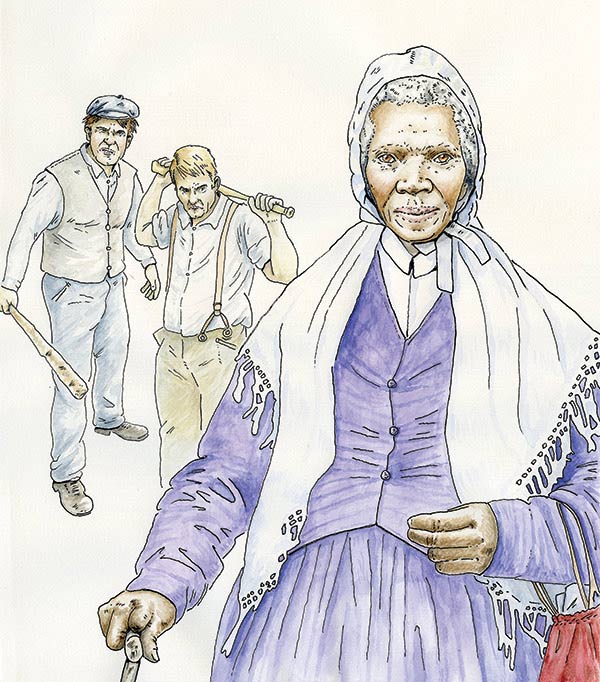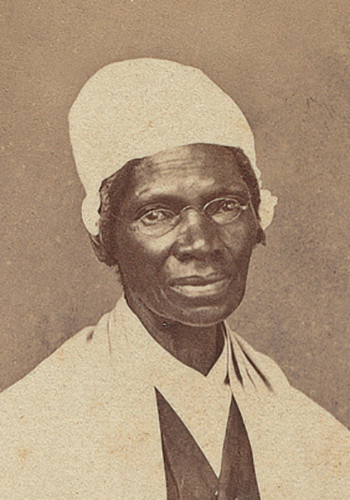Subtotal: $
Checkout-

Covering the Cover: What Are Families For?
-

Another View: Sunday Supper
-

Proteus Unbound
-

The First Society
-

The Corporate Parent
-

Family Matters
-

Letters from Readers
-

Family and Friends: Issue 26
-

The Case for One More Child
-

The Best of Times, the Worst of Times
-

Return to Vienna
-

You Can’t Go Home Again
-

Two Poems
-

Why Inheritance Matters
-

Not Just Nuclear
-

Dependence
-

The Praying Feminist
-

Letters from Death Row
-

The Beautiful Institution
-

Putting Marriage Second
-

Singles in the Pew
-

New Prince, New Pompe
-

Manly Virtues
-

God in a Cave
-

Editors’ Picks: Issue 26
-

Little Women, Rebel Angels

Sojourner Truth
By Susannah Black Roberts and Jason Landsel
January 15, 2021
Available languages: français
Next Article:
Explore Other Articles:
In 1844, in a field outside the town of Northampton, Massachusetts, a gang of young men showed up at a revival meeting, making trouble. The meeting’s organizers grew angry; the men – more than a hundred – redoubled their uproar. One of the meeting attendees, a forty-seven-year-old woman, hid behind a chest in the corner of the tent: “I am the only colored person here,” she thought, “and on me, probably, their wicked mischief will fall first, and perhaps fatally.”
The young men started to rock the tent-poles. And she gave herself a talking-to.
“Shall I run away and hide from the devil? Me, a servant of the living God? Have I not faith enough to go out and quell that mob?” She tried, unsuccessfully, to convince a couple of friends to confront the men with her. She left the tent alone, and, the moon bright on the field, she walked up a rise nearby and began to sing.
Sojourner Truth always was a powerful singer.
It got their attention. And after a few minutes’ conversation, she managed to talk them into leaving.
She was born Isabella Baumfree, and grew up in slavery in Rifton, a hamlet in upstate New York. She remembered her mother teaching her the Lord’s Prayer in Dutch, her first language. When she was nine, she was sold, along with a flock of sheep, away from her family. At eighteen, she fell in love with Robert, owned by a neighbor of her enslaver, John Dumont; they had a son, James, who died soon after he was born. This relationship didn’t sit well with Robert’s owner, and she was later made to marry one of Dumont’s slaves, Thomas; all their children would then belong to Dumont. She had four more surviving children. Diana was the child of her rape by Dumont; Peter, Elizabeth, and Sophia were her children with Thomas.

Jason Landsel, Sojourner Truth. Image courtesy of Jason Landsel
Slavery in New York State was on its way out. After July 4, 1827, all enslaved people in the state would be free. After Dumont reneged on a promise to free Isabella a year early, she escaped, taking with her Sophia, who was still a baby. She found a job with a Quaker couple, Mr. and Mrs. Van Wagenen, in nearby New Paltz, New York.
She had had, as she later described it to her biographer Olive Gilbert, the habit of bringing her complaints to God, bargaining her good behavior for his doing what she asked. But at the Van Wagenens’, she fell out of the habit of prayer. One day, though, she had the first of a remarkable series of experiences. God, she said, showed her, “on the twinkling of an eye, that he was all over”– “Oh, God,” she remembers saying aloud, “I did not know you were so big.” She had a sense too of her own sin. How had she dared to bargain with him? In the words of her biographer, “She began to wish for someone to speak to God for her.… At length a friend appeared to stand between herself and an insulted Deity.” It was a vision, which “brightened into a form distinct, beaming with the beauty of holiness, and radiant with love.” She spoke out loud to it. “I know you, and I don’t know you.… Who are you?” “Her whole soul,” as she described it, “was in one deep prayer.… An answer came to her.… ‘It is Jesus.’”
An unexpected answer. She had “heard Jesus mentioned.… but had received from what she heard no impression that he was any other than an eminent man, like a Washington or a Lafayette. Now he appeared.… And God was no longer a terror and a dread to her.”
It was an experience that would remain a guide for the rest of her life.
Shortly afterward, she learned that Dumont had illegally sold her five-year-old son Peter down south to Alabama. She went back to Dumont’s house, confronting his wife. “Haven’t you as many of ’em left as you can see to?” her former mistress asked. “What have you to support him with, if you could [find him]?” “I have no money,” she said, “but God has enough!… And I’ll have my child again.”
“I felt so tall within,” she said of that moment; “I felt as if the power of a nation was with me!” She found Peter, and took the man who had bought him to court. And won: the first black woman to win a legal battle against a white man in US history.

Sojourner Truth, 1864
She was free. And, after July 4 of that year, all of her children were as well. But so many more were not. And where there was not slavery, there was wage slavery. She felt called to travel, to speak about the need for true brotherhood in Christ, “testifying of the hope that was in her.” And she took a new name: Sojourner.
Her travels took her north; she joined an intentional community in Massachusetts, meeting with the lights of the antebellum abolitionist movement: William Lloyd Garrison, Frederick Douglass, and others.
Sojourner Truth lived until 1883, speaking and organizing for abolition and then for women’s rights and the abolition of capital punishment. To the end of her days, a fierce personal faith in Christ gave her strength and guided her struggle for a more humane order of society.
She died on November 26, 1883. She is buried with her family in Battle Creek, Michigan.
“I can’t read,” she explained, in a speech in May of 1851, “but I can hear. I have heard the Bible and have learned that Eve caused man to sin. Well if woman upset the world, do give her a chance to set it right side up again. Jesus.… never spurned woman from him.… When Lazarus died, Mary and Martha came to him with faith and love and besought him to raise their brother. And Jesus wept – and Lazarus came forth.”
Already a subscriber? Sign in
Try 3 months of unlimited access. Start your FREE TRIAL today. Cancel anytime.






































Shannon
Very beautiful. Christs' Own IS beautiful. There is divine glory in Sojourner Truth's suffering bearing Kingdom fruit. Thank you for this encouragement. I am grateful for this woman's life living fully with Christ. A great witness of childlike faith and example for this day. Today.
Sidney R Sparks
I knew about this remarkable lady, and her tenacious application of faith and trust in God. Thus, a big salute to PLOUGH for posting this "snippet" of her life!
Kostas Sarantidis
Eve gets blamed a lot for the 'original sin'. Sojourner Truth did not shy away from the usual blame, but what an amazing response she offered: "Well if woman upset the world, do give her a chance to set it right side up again." This is the most fabulous and most challenging anyone has ever said in response to the accusation against Eve. Jesus would have approved! Jesus does approve!
Amanda Pato
This is a sad story its painful to be a Black woman all over the world even where I'm staying in South Africa its the same we Black woman we suffer.